The Hill of Tara and Brú Na Bóinne
Wednesday, September 23, 2009
 Our brief stop in Liverpool surprised me. The lovely parks and blend of old and modern architecture we viewed "In the Footsteps of the Beatles" quickly dispelled our ideas of a sooty, industrial city. We had great fun seeing the haunts and homes of John, Paul, George, and Ringo, including a museum dedicated to their rise to stardom. 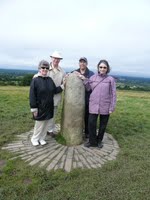 By the next morning, our ship had crossed the Irish Sea and berthed in Dublin Port. We set out early with my aunt and uncle for a day trip back in time, to the royal county of Meath. Our tour began with a visit to the Hill of Tara, seat of the High Kings of Ireland. Here w 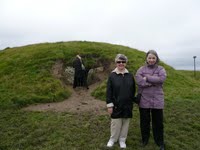 e are with the Lia Fáil, the Stone of Destiny, said to roar when the rightful High King touched it, though it remained silent beneath our reverent touch. Our knowledgeable tour guide described the standing stones, King Cormac's House, and the Mound of the Hostages, pictured to the right behind Diane and me. Despite years of excavation, much remains unknown about this mystical site. Our next stop was UNESCO World Heritage Site Brú Na Bóinne, Irish for the Palace of the Boyne, often  referred to as the Bend in the Boyne, more comm  only known as the Boyne Valley. This fertile area of County Meath contains the remains of forty or so neolithic passage tombs built around 3,000 B.C., which makes them over 5,000 years old, older than the pyramids of Egypt. The enormous megalithic tombs of Newgrange (pictured), Knowth, an d Dowth dominate the landscape. Mike and I had visited Newgrange twice, but this was our first visit to Knowth, where the largest number of tombs to date have been excavated. The ancient people who built them constructed the famous facade of Newgrange from white quartz they quarried fifty miles south in the Wicklow Mountains.  Passage tombs are found throughout Atlantic Europe, particularly in France and Brittany. They are circular mounds containing a passage and at least one chamber. The mounds are encircled by kerb stones, 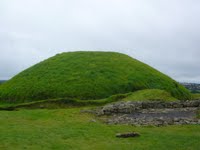 many of which display mysterious designs and carvings. The Knowth complex lies at the western end of Brú Na Bóinne. The massive passage grave is ringed by 127 large kerb stones decorated with  neolithic artwork. Visitors are allowed partway inside for a glimpse into history. After we enjoyed the eerie sight, we climbed to the top of the mound and  enjoyed a breathtaking view of the valley. Wondering how the area had looked 5,000 years ago and what the people who'd lived here were like, we wandered around the ancient mound and its eighteen satellite tombs until it was time to return to the ship.  
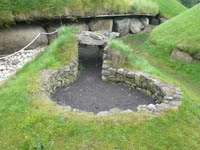 Labels: Brú Na Bóinne, High Kings, Hill of Tara, Knowth, Newgrange, Passage Tombs
Posted by Pat McDermott
at 9:11 PM
•  
8
comments • Post a Comment
show/hide comments
Return to Main Blog Page
Return to Pat McDermott Homepage
The Giant's Causeway
Thursday, September 17, 2009
 The oldest theory concerning the origin of The Giant’s Causeway maintains that this amazing stretch of Ireland’s North Antrim coast is all that remains of a bridge formed long ago The oldest theory concerning the origin of The Giant’s Causeway maintains that this amazing stretch of Ireland’s North Antrim coast is all that remains of a bridge formed long ago by the giant Finn MacCool to link Ireland and Scotland. by the giant Finn MacCool to link Ireland and Scotland.
The main hero of the Fenian Cycle of Irish mythology, Finn led the Fianna, a band of warriors who roamed around Ireland in the third century AD.
 Finn shows up in many entertaining tales. The legend concerning the Causeway depicts him as a mighty giant seeking to do battle with his rival, the Scottish giant Benandonner. Being a hospitable sort, Finn set a series of huge stepping stones acros  s the Irish Sea to allow Benandonner to come over to fight without wetting his feet. But when Finn saw the monstrous size of the approaching giant, he ran home and asked his wife to hide him. She dressed him as a baby and placed him in a giant cradle. When Benandonner saw what he thought was an infant, he concluded that the child’s father must be huge indeed. Terrified, Benandonner fled back to Scotland, tearing up the stepping stones as he ran so Finn couldn’t follow.  The geologists tell a less fanciful story. The Causeway is part of the Antrim Plateau, the largest lava plateau left in Europe. The massive cliffs projecting into the Atlantic Ocean are the result of volcanic activity that tranpsire 60 million years ago. Lava filled a riverbed and cooled slowly, cracking into p 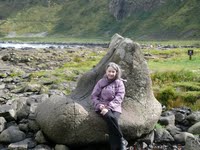 olygonal columns and forming unusually shaped structures with intriguing names like the Giant’s Boot (pictured with me sitting in it) and the Giant’s Organ (nothing anatomical here - it seems Finn created a pipe organ for his son Oisin to play). Our visit to the Causeway, a World Heritage site we’ve wanted to visit for years but couldn’t seem to fit into our travels, was a shore excursion offered by our cruise line. We visited Antrim during typical Irish weather: blue skies one minute, rain the next. Lot  s of folks got wet, but everyone was smiling. We saw several rainbows before returning to our tour bus for a drive down the lovely Antrim coast. 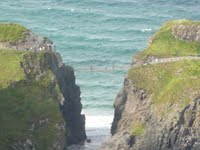 After a delicious lunch at a local hotel, we stopped briefly at the remains of historic Dunluce Castle and viewed the Carrick-a-Rede Rope Bridge, which we did not cross. Back to the ship we went to prepare for the next day’s tour: Liverpool.
View the video of the Causeway's gorgeous sweep!
Labels: Antrim, Dunluce Castle, Finn MacCool, Giant's Causeway
Posted by Pat McDermott
at 4:33 PM
•  
12
comments • Post a Comment
show/hide comments
Return to Main Blog Page
Return to Pat McDermott Homepage
The Edinburgh Military Tattoo
Friday, September 11, 2009
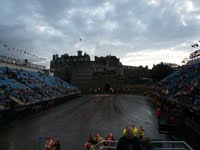 We stood in a long line leading up to Edinburgh Castle grateful for the hoods on our jackets. A round of Scottish showers dampened everything but our spirits. A rainbow burst acr We stood in a long line leading up to Edinburgh Castle grateful for the hoods on our jackets. A round of Scottish showers dampened everything but our spirits. A rainbow burst acr oss the roiling clouds as the line started moving, a good omen we hoped. The Tattoo would take place outdoors. As it turned out, the rain held off for the rest of the evening. We climbed the stands to seats facing the castle, the best seats in the house, courtesy of our pampering cruise line. oss the roiling clouds as the line started moving, a good omen we hoped. The Tattoo would take place outdoors. As it turned out, the rain held off for the rest of the evening. We climbed the stands to seats facing the castle, the best seats in the house, courtesy of our pampering cruise line.
Scotland first presented The Edinburgh Military Tattoo in 1950. The Tattoo's current patron is Anne, Princess Royal. With an annual audience of over 200,000 and 100 million viewers watching on international television, this electrifying it’s generally consid ered the biggest and best Military Tattoo in the world. ered the biggest and best Military Tattoo in the world.
"Tattoo" in the military sense has nothing to do with puncturing the skin to create indelible designs. The word comes from "Doe den tap toe," a Dutch phrase meaning "put the tap to" or "turn off the tap." In th  e Lowland Countries during the 17th and 18th centuries, the cry told tavern owners it was time to turn off their ale taps. The British Army, stationed in Flanders during the War of the Austrian Succession, adopted the phrase and transformed it into a ritual performed by their drummers and pipers each night to round up their troops. The "Tattoo" soon became the last duty call of the day and eventually came to mean an evening performance by military musicians.  And a performance is what we got. I expected the splendid show of hundreds of kilts, bagpipes and drums. I didn’t realize we’d see military bands from all over the world, including the South Sea Island of Tonga, Switzerland, China, South Africa, and Australia. A thrilling flyover by a Royal Air Force jet  began the show. Marching bands then entered the esplanade with the torchlit castle providing a backdrop for ingenious light shows and an occasional display of fireworks. This year’s Tattoo coincided with the 250th anniversary of the birth of Robert Burns, and members of the Royal Scottish Academy of Music and Drama treated us to special presentations of his so  ngs and stories.
After the big finale, the chilling sound of the Lone Piper playing from the top of the castle signaled the end of the pageant. The March Out had everyone in the stands cheering. In high spirits, we made our way back to the ship. We'd seen The Tattoo!
Check out this video of Switzerland's Top Secret Drum Corps!
Labels: Edinburgh, military tattoo, Scotland
Posted by Pat McDermott
at 10:12 AM
•  
9
comments • Post a Comment
show/hide comments
Return to Main Blog Page
Return to Pat McDermott Homepage
Cruising Into History
Wednesday, September 9, 2009
 A brief but pleasant stopover in Dublin helped us acclimate ourselves to the A brief but pleasant stopover in Dublin helped us acclimate ourselves to the  five-hour time change between New Hampshire and the British Isles. For the better part of three days, we enjoyed our favorite restaurants and bookstores and revisited familiar spots. We also paid our first visit to Ireland’s National Botanic Gardens, established in 1795. We found this gorgeous urban retreat filled with flowers and plants from all over the world and set in a wide variety of themed garden five-hour time change between New Hampshire and the British Isles. For the better part of three days, we enjoyed our favorite restaurants and bookstores and revisited familiar spots. We also paid our first visit to Ireland’s National Botanic Gardens, established in 1795. We found this gorgeous urban retreat filled with flowers and plants from all over the world and set in a wide variety of themed garden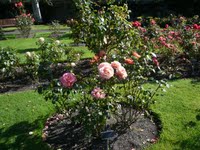 s. Desert and tropical rainforest flora thrived in an array of greenhouses that are an adventure all their own. From the formal rose garden to the more casual s. Desert and tropical rainforest flora thrived in an array of greenhouses that are an adventure all their own. From the formal rose garden to the more casual 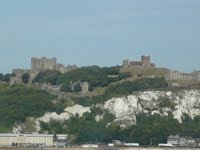 marsh and woodland plantings, this Dublin paradise and its ponds were not only a joy to explore, but free of charge. marsh and woodland plantings, this Dublin paradise and its ponds were not only a joy to explore, but free of charge.
After a few sunny days in Ireland’s tourist-packed capital, we hopped an early morning shuttle to Heathrow Airport. Two Crystal Cruise reps brought us to a minivan, and we were quickly on our way to Dover with three other shipmates. When we arrived, the sight of those famous white cliffs  astounded us. So beautiful, and Dover Castle atop them made it easy to visualize the area as it must have looked centuries ago, without all the modern commercialization. The Crystal Symphony awaited us at the dock. After we completed the  boarding process, a staff member escorted us to a lounge on Deck Eleven ( Symphony has twelve in all). He apologized that our rooms weren’t ready. Not a problem. Several glasses of complimentary French champagne, a spectacular view of those white cliffs, and the realization that we’d traveled from Dover, New Hampshire to Dover, England in a few short days kept us very merry indeed. 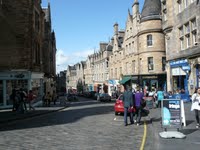 Wobbling to our stateroom several glasses of champagne later, we met my aunt and uncle, the perpetrators of the whole cruise idea, bless them. We settled into our well-appointed rooms and went to the main dining room to sample the first of many outstanding dinners. Soon we were underway, sailing the North Sea through the night and all the next day, passing England’s eastern shores on our way to southeast Scotland. Our day at sea gave us a chance to explore the ship: The library, the movie and Broadway style theaters, shops, a gymnasium, a tennis court, specialty restaurants, even a casino. At last,  Symphony Symphony berthed in Rosyth on the Firth of Forth. After a fortifying breakfast, we boarded a shuttle bus for the forty minute ride into the City of Edinburgh, the capital of Scotland.  Knowing our time was limited—we would only have two days in Edinburgh, hardly enough—we saw what little we could of a splendid medieval city oozing with history. We scurried to find the Royal Mile and found the traffic-free thoroughfare jammed with buskers and street musicians: The Edinburgh Festival was underway. Omnipresent pipers in traditional dress filled the air with music distinctly Scottish. An official guide stationed on a busy corner pointed us toward Edinburgh Castle. We climbed to the top of the steep cobblest  one street packed with kilts and cashmere shops.  When we reached the castle, we found stadium style stands set up on its esplanade. This was where we’d attend the Edinburgh Military Tattoo. Opting to return the next day to see more of the castle and Holyrood Palace, along with as much as the Hop On/Hop Off tour bus allowed, we enjoyed lunch in a whisky (no "e" in Scottish whiskey) museum. Edinburgh had captured us. We decided we’d visit again one day on our own. We’d wander through the New and Old Towns, explore the underground vaults, and take our time visiting museums, shops, and the zoo. With that pleasant thought in mind, we took the shuttle back to the ship to prepare for the Tattoo. Labels: Edinburgh, festival, National Botanic Gardens, Royal Mile, Scotland
Posted by Pat McDermott
at 12:41 PM
•  
8
comments • Post a Comment
show/hide comments
Return to Main Blog Page
Return to Pat McDermott Homepage
|

